technical specifications FIAT DUCATO 2012 Owner handbook (in English)
[x] Cancel search | Manufacturer: FIAT, Model Year: 2012, Model line: DUCATO, Model: FIAT DUCATO 2012Pages: 287, PDF Size: 4.5 MB
Page 147 of 287
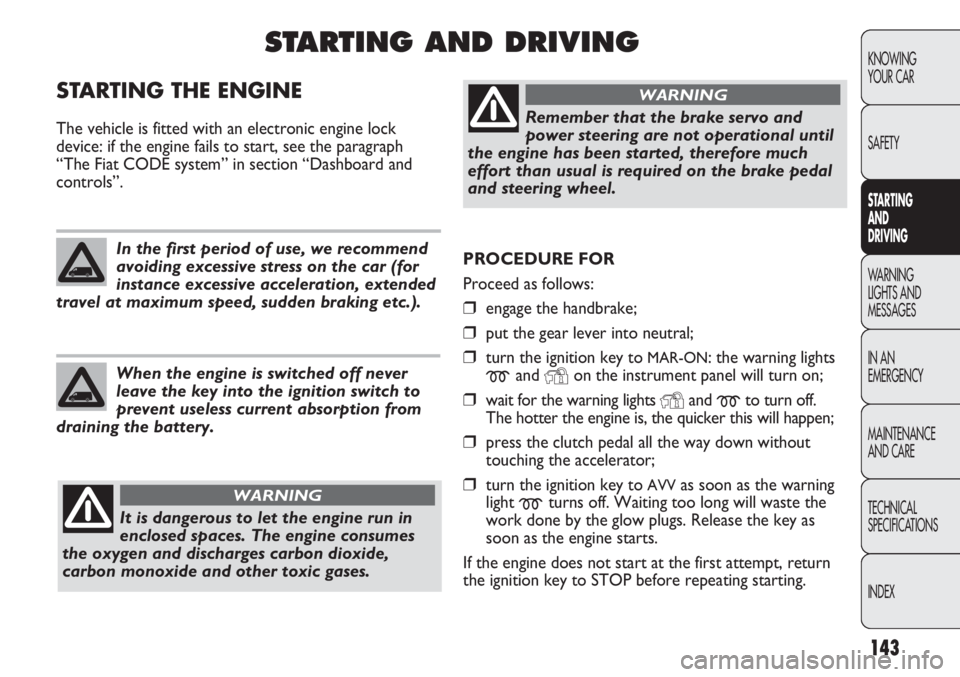
143
KNOWING
YOUR CAR
SAFETY
STARTING
AND
DRIVING
WARNING
LIGHTS AND
MESSAGES
IN AN
EMERGENCY
MAINTENANCE
AND CARE
TECHNICAL
SPECIFICATIONS
INDEX
PROCEDURE FOR
Proceed as follows:
❒engage the handbrake;
❒put the gear lever into neutral;
❒turn the ignition key to MAR-ON: the warning lights
mand Yon the instrument panel will turn on;
❒wait for the warning lights Yand mto turn off.
The hotter the engine is, the quicker this will happen;
❒press the clutch pedal all the way down without
touching the accelerator;
❒turn the ignition key to AVVas soon as the warning
light
mturns off. Waiting too long will waste the
work done by the glow plugs. Release the key as
soon as the engine starts.
If the engine does not start at the first attempt, return
the ignition key to STOP before repeating starting.
STARTING THE ENGINE
The vehicle is fitted with an electronic engine lock
device: if the engine fails to start, see the paragraph
“The Fiat CODE system” in section “Dashboard and
controls”.
STARTING AND DRIVING
It is dangerous to let the engine run in
enclosed spaces. The engine consumes
the oxygen and discharges carbon dioxide,
carbon monoxide and other toxic gases.
WARNING
In the first period of use, we recommend
avoiding excessive stress on the car (for
instance excessive acceleration, extended
travel at maximum speed, sudden braking etc.).
When the engine is switched off never
leave the key into the ignition switch to
prevent useless current absorption from
draining the battery.
Remember that the brake servo and
power steering are not operational until
the engine has been started, therefore much
effort than usual is required on the brake pedal
and steering wheel.
WARNING
Page 148 of 287
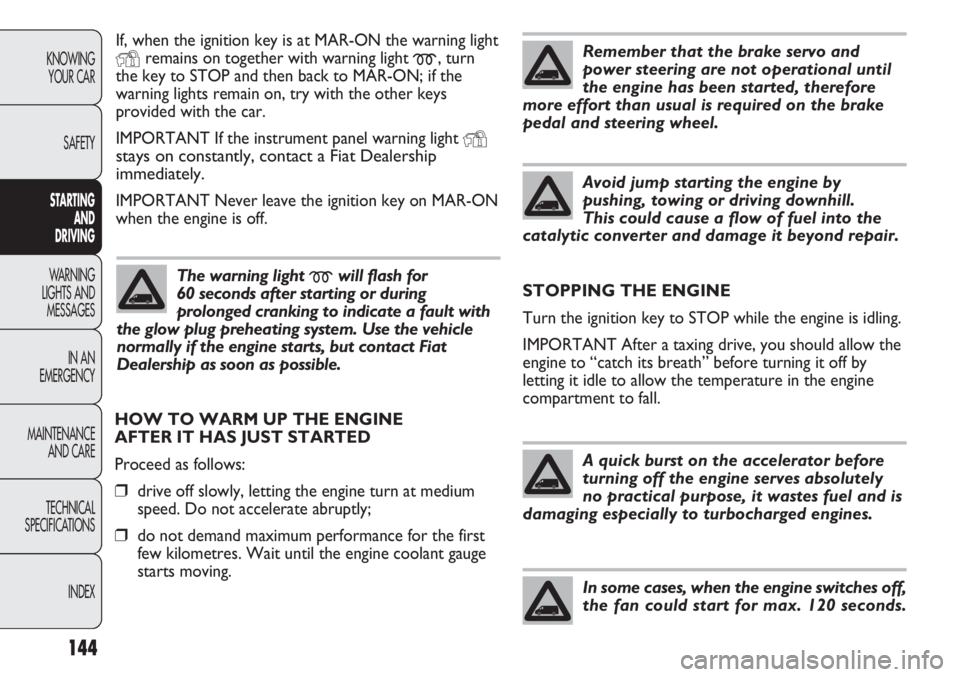
144
KNOWING
YOUR CAR
SAFETY
STARTING
AND
DRIVING
WARNING
LIGHTS AND
MESSAGES
IN AN
EMERGENCY
MAINTENANCE
AND CARE
TECHNICAL
SPECIFICATIONS
INDEX
If, when the ignition key is at MAR-ON the warning light
Yremains on together with warning light m, turn
the key to STOP and then back to MAR-ON; if the
warning lights remain on, try with the other keys
provided with the car.
IMPORTANT If the instrument panel warning light
Ystays on constantly, contact a Fiat Dealership
immediately.
IMPORTANT Never leave the ignition key on MAR-ON
when the engine is off.
The warning light mwill flash for
60 seconds after starting or during
prolonged cranking to indicate a fault with
the glow plug preheating system. Use the vehicle
normally if the engine starts, but contact Fiat
Dealership as soon as possible.
Remember that the brake servo and
power steering are not operational until
the engine has been started, therefore
more effort than usual is required on the brake
pedal and steering wheel.
Avoid jump starting the engine by
pushing, towing or driving downhill.
This could cause a flow of fuel into the
catalytic converter and damage it beyond repair.
HOW TO WARM UP THE ENGINE
AFTER IT HAS JUST STARTED
Proceed as follows:
❒drive off slowly, letting the engine turn at medium
speed. Do not accelerate abruptly;
❒do not demand maximum performance for the first
few kilometres. Wait until the engine coolant gauge
starts moving.STOPPING THE ENGINE
Turn the ignition key to STOP while the engine is idling.
IMPORTANT After a taxing drive, you should allow the
engine to “catch its breath” before turning it off by
letting it idle to allow the temperature in the engine
compartment to fall.
A quick burst on the accelerator before
turning off the engine serves absolutely
no practical purpose, it wastes fuel and is
damaging especially to turbocharged engines.
In some cases, when the engine switches off,
the fan could start for max. 120 seconds.
Page 149 of 287
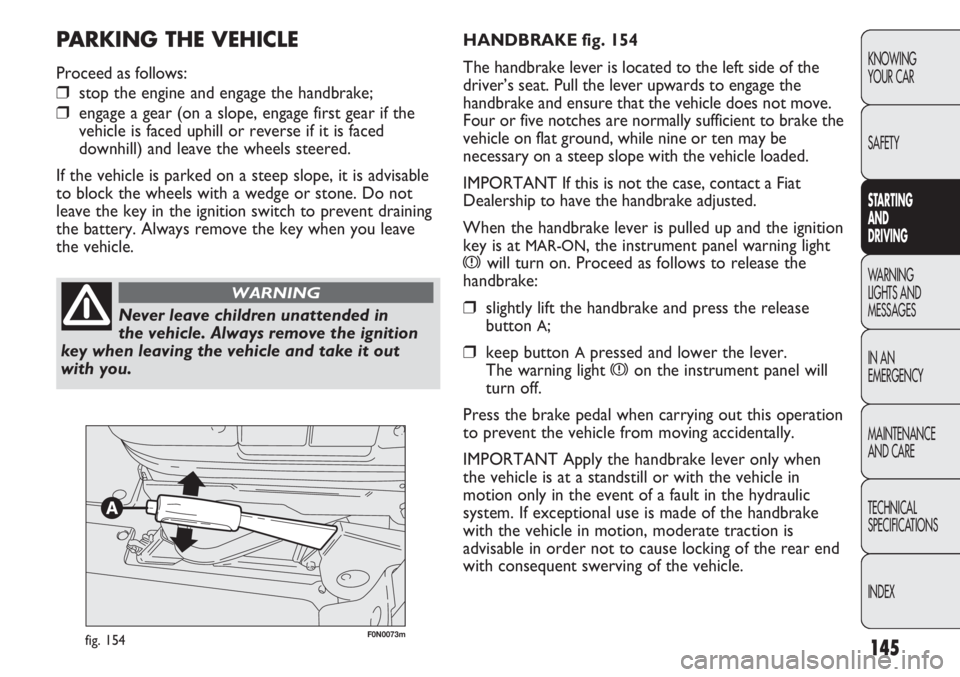
145
KNOWING
YOUR CAR
SAFETY
STARTING
AND
DRIVING
WARNING
LIGHTS AND
MESSAGES
IN AN
EMERGENCY
MAINTENANCE
AND CARE
TECHNICAL
SPECIFICATIONS
INDEX
F0N0073mfig. 154
HANDBRAKE fig. 154
The handbrake lever is located to the left side of the
driver’s seat. Pull the lever upwards to engage the
handbrake and ensure that the vehicle does not move.
Four or five notches are normally sufficient to brake the
vehicle on flat ground, while nine or ten may be
necessary on a steep slope with the vehicle loaded.
IMPORTANT If this is not the case, contact a Fiat
Dealership to have the handbrake adjusted.
When the handbrake lever is pulled up and the ignition
key is at
MAR-ON, the instrument panel warning light
xwill turn on. Proceed as follows to release the
handbrake:
❒slightly lift the handbrake and press the release
button
A;
❒keep button Apressed and lower the lever.
The warning light
xon the instrument panel will
turn off.
Press the brake pedal when carrying out this operation
to prevent the vehicle from moving accidentally.
IMPORTANT Apply the handbrake lever only when
the vehicle is at a standstill or with the vehicle in
motion only in the event of a fault in the hydraulic
system. If exceptional use is made of the handbrake
with the vehicle in motion, moderate traction is
advisable in order not to cause locking of the rear end
with consequent swerving of the vehicle.
PARKING THE VEHICLE
Proceed as follows:
❒stop the engine and engage the handbrake;
❒engage a gear (on a slope, engage first gear if the
vehicle is faced uphill or reverse if it is faced
downhill) and leave the wheels steered.
If the vehicle is parked on a steep slope, it is advisable
to block the wheels with a wedge or stone. Do not
leave the key in the ignition switch to prevent draining
the battery. Always remove the key when you leave
the vehicle.
Never leave children unattended in
the vehicle. Always remove the ignition
key when leaving the vehicle and take it out
with you.
WARNING
Page 150 of 287
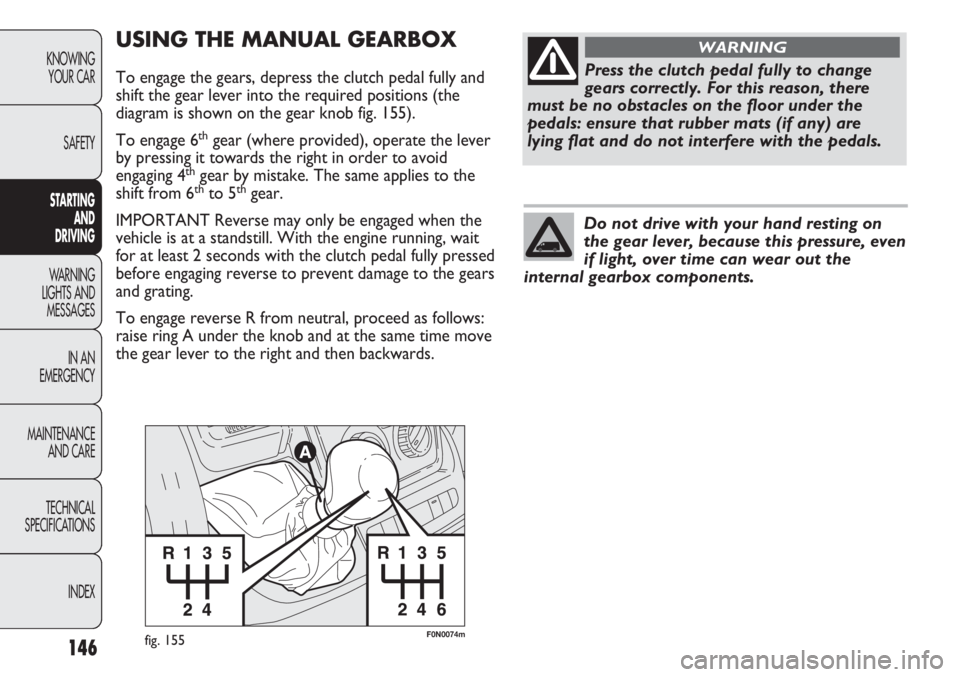
146
KNOWING
YOUR CAR
SAFETY
STARTING
AND
DRIVING
WARNING
LIGHTS AND
MESSAGES
IN AN
EMERGENCY
MAINTENANCE
AND CARE
TECHNICAL
SPECIFICATIONS
INDEX
F0N0074mfig. 155
USING THE MANUAL GEARBOX
To engage the gears, depress the clutch pedal fully and
shift the gear lever into the required positions (the
diagram is shown on the gear knob fig. 155).
To engage 6
thgear (where provided), operate the lever
by pressing it towards the right in order to avoid
engaging 4
thgear by mistake. The same applies to the
shift from 6thto 5thgear.
IMPORTANT Reverse may only be engaged when the
vehicle is at a standstill. With the engine running, wait
for at least 2 seconds with the clutch pedal fully pressed
before engaging reverse to prevent damage to the gears
and grating.
To engage reverse R from neutral, proceed as follows:
raise ring A under the knob and at the same time move
the gear lever to the right and then backwards.
Press the clutch pedal fully to change
gears correctly. For this reason, there
must be no obstacles on the floor under the
pedals: ensure that rubber mats (if any) are
lying flat and do not interfere with the pedals.
WARNING
Do not drive with your hand resting on
the gear lever, because this pressure, even
if light, over time can wear out the
internal gearbox components.
Page 151 of 287
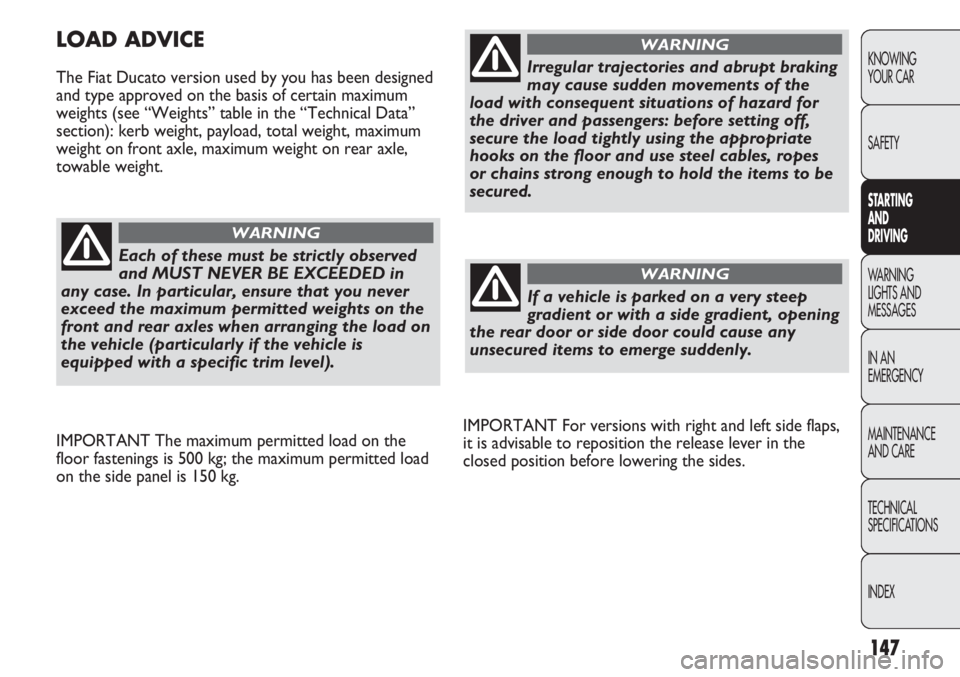
147
KNOWING
YOUR CAR
SAFETY
STARTING
AND
DRIVING
WARNING
LIGHTS AND
MESSAGES
IN AN
EMERGENCY
MAINTENANCE
AND CARE
TECHNICAL
SPECIFICATIONS
INDEX
IMPORTANT For versions with right and left side flaps,
it is advisable to reposition the release lever in the
closed position before lowering the sides.
LOAD ADVICE
The Fiat Ducato version used by you has been designed
and type approved on the basis of certain maximum
weights (see “Weights” table in the “Technical Data”
section): kerb weight, payload, total weight, maximum
weight on front axle, maximum weight on rear axle,
towable weight.
Each of these must be strictly observed
and MUST NEVER BE EXCEEDED in
any case. In particular, ensure that you never
exceed the maximum permitted weights on the
front and rear axles when arranging the load on
the vehicle (particularly if the vehicle is
equipped with a specific trim level).
WARNING
IMPORTANT The maximum permitted load on the
floor fastenings is 500 kg; the maximum permitted load
on the side panel is 150 kg.
Irregular trajectories and abrupt braking
may cause sudden movements of the
load with consequent situations of hazard for
the driver and passengers: before setting off,
secure the load tightly using the appropriate
hooks on the floor and use steel cables, ropes
or chains strong enough to hold the items to be
secured.
WARNING
If a vehicle is parked on a very steep
gradient or with a side gradient, opening
the rear door or side door could cause any
unsecured items to emerge suddenly.
WARNING
Page 152 of 287
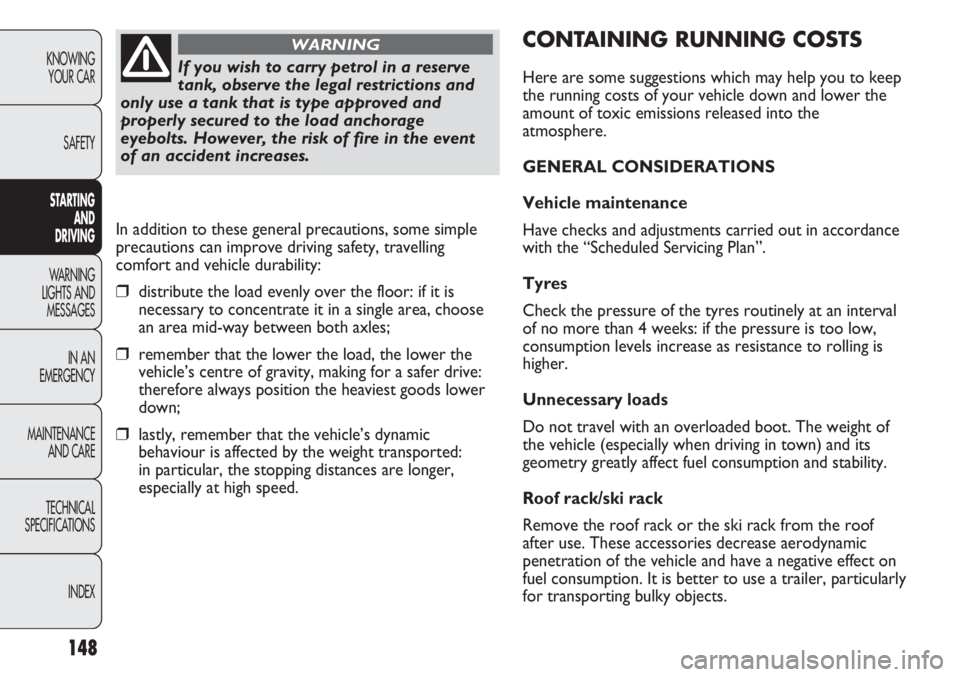
148
KNOWING
YOUR CAR
SAFETY
STARTING
AND
DRIVING
WARNING
LIGHTS AND
MESSAGES
IN AN
EMERGENCY
MAINTENANCE
AND CARE
TECHNICAL
SPECIFICATIONS
INDEX
CONTAINING RUNNING COSTS
Here are some suggestions which may help you to keep
the running costs of your vehicle down and lower the
amount of toxic emissions released into the
atmosphere.
GENERAL CONSIDERATIONS
Vehicle maintenance
Have checks and adjustments carried out in accordance
with the “Scheduled Servicing Plan”.
Tyres
Check the pressure of the tyres routinely at an interval
of no more than 4 weeks: if the pressure is too low,
consumption levels increase as resistance to rolling is
higher.
Unnecessary loads
Do not travel with an overloaded boot. The weight of
the vehicle (especially when driving in town) and its
geometry greatly affect fuel consumption and stability.
Roof rack/ski rack
Remove the roof rack or the ski rack from the roof
after use. These accessories decrease aerodynamic
penetration of the vehicle and have a negative effect on
fuel consumption. It is better to use a trailer, particularly
for transporting bulky objects. In addition to these general precautions, some simple
precautions can improve driving safety, travelling
comfort and vehicle durability:
❒distribute the load evenly over the floor: if it is
necessary to concentrate it in a single area, choose
an area mid-way between both axles;
❒remember that the lower the load, the lower the
vehicle’s centre of gravity, making for a safer drive:
therefore always position the heaviest goods lower
down;
❒lastly, remember that the vehicle’s dynamic
behaviour is affected by the weight transported:
in particular, the stopping distances are longer,
especially at high speed.
If you wish to carry petrol in a reserve
tank, observe the legal restrictions and
only use a tank that is type approved and
properly secured to the load anchorage
eyebolts. However, the risk of fire in the event
of an accident increases.
WARNING
Page 153 of 287
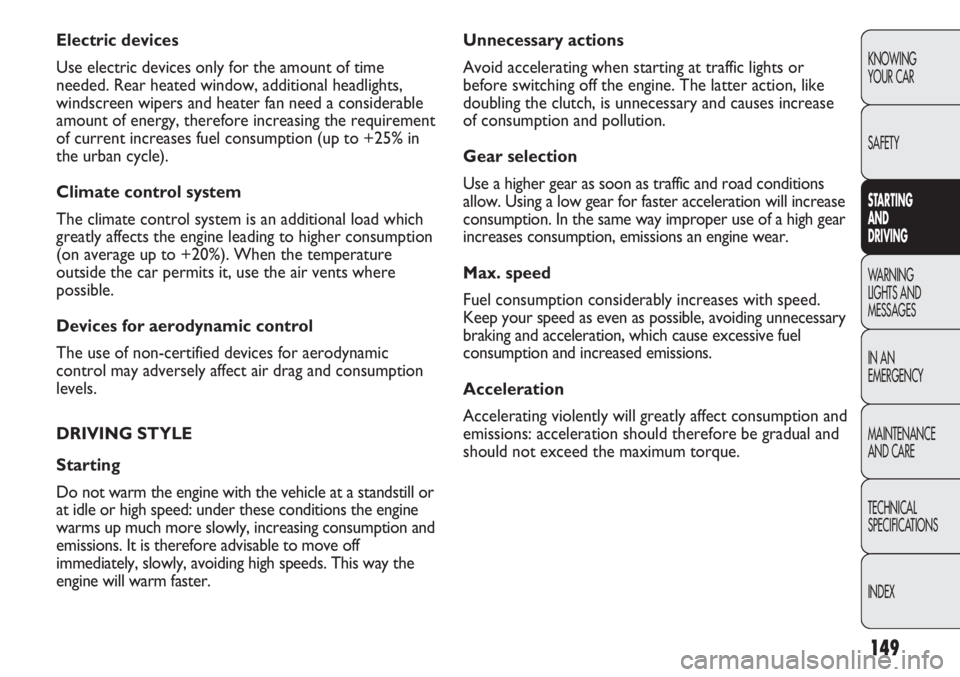
149
KNOWING
YOUR CAR
SAFETY
STARTING
AND
DRIVING
WARNING
LIGHTS AND
MESSAGES
IN AN
EMERGENCY
MAINTENANCE
AND CARE
TECHNICAL
SPECIFICATIONS
INDEX
Unnecessary actions
Avoid accelerating when starting at traffic lights or
before switching off the engine. The latter action, like
doubling the clutch, is unnecessary and causes increase
of consumption and pollution.
Gear selection
Use a higher gear as soon as traffic and road conditions
allow. Using a low gear for faster acceleration will increase
consumption. In the same way improper use of a high gear
increases consumption, emissions an engine wear.
Max. speed
Fuel consumption considerably increases with speed.
Keep your speed as even as possible, avoiding unnecessary
braking and acceleration, which cause excessive fuel
consumption and increased emissions.
Acceleration
Accelerating violently will greatly affect consumption and
emissions: acceleration should therefore be gradual and
should not exceed the maximum torque. Electric devices
Use electric devices only for the amount of time
needed. Rear heated window, additional headlights,
windscreen wipers and heater fan need a considerable
amount of energy, therefore increasing the requirement
of current increases fuel consumption (up to +25% in
the urban cycle).
Climate control system
The climate control system is an additional load which
greatly affects the engine leading to higher consumption
(on average up to +20%). When the temperature
outside the car permits it, use the air vents where
possible.
Devices for aerodynamic control
The use of non-certified devices for aerodynamic
control may adversely affect air drag and consumption
levels.
DRIVING STYLE
Starting
Do not warm the engine with the vehicle at a standstill or
at idle or high speed: under these conditions the engine
warms up much more slowly, increasing consumption and
emissions. It is therefore advisable to move off
immediately, slowly, avoiding high speeds. This way the
engine will warm faster.
Page 154 of 287
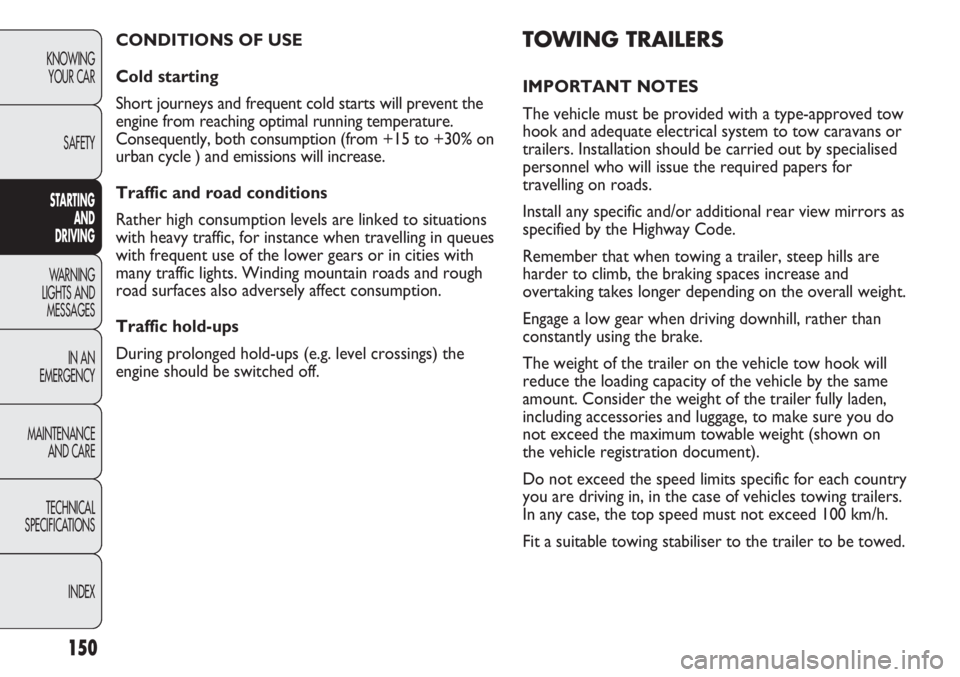
150
KNOWING
YOUR CAR
SAFETY
STARTING
AND
DRIVING
WARNING
LIGHTS AND
MESSAGES
IN AN
EMERGENCY
MAINTENANCE
AND CARE
TECHNICAL
SPECIFICATIONS
INDEX
TOWING TRAILERS
IMPORTANT NOTES
The vehicle must be provided with a type-approved tow
hook and adequate electrical system to tow caravans or
trailers. Installation should be carried out by specialised
personnel who will issue the required papers for
travelling on roads.
Install any specific and/or additional rear view mirrors as
specified by the Highway Code.
Remember that when towing a trailer, steep hills are
harder to climb, the braking spaces increase and
overtaking takes longer depending on the overall weight.
Engage a low gear when driving downhill, rather than
constantly using the brake.
The weight of the trailer on the vehicle tow hook will
reduce the loading capacity of the vehicle by the same
amount. Consider the weight of the trailer fully laden,
including accessories and luggage, to make sure you do
not exceed the maximum towable weight (shown on
the vehicle registration document).
Do not exceed the speed limits specific for each country
you are driving in, in the case of vehicles towing trailers.
In any case, the top speed must not exceed 100 km/h.
Fit a suitable towing stabiliser to the trailer to be towed. CONDITIONS OF USE
Cold starting
Short journeys and frequent cold starts will prevent the
engine from reaching optimal running temperature.
Consequently, both consumption (from +15 to +30% on
urban cycle ) and emissions will increase.
Traffic and road conditions
Rather high consumption levels are linked to situations
with heavy traffic, for instance when travelling in queues
with frequent use of the lower gears or in cities with
many traffic lights. Winding mountain roads and rough
road surfaces also adversely affect consumption.
Traffic hold-ups
During prolonged hold-ups (e.g. level crossings) the
engine should be switched off.
Page 155 of 287
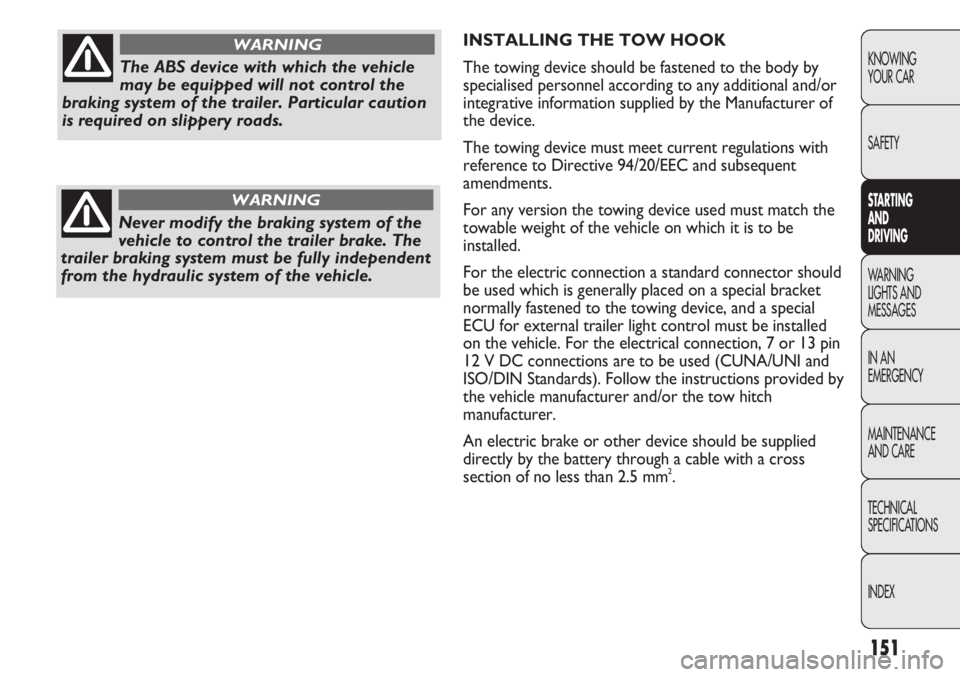
151
KNOWING
YOUR CAR
SAFETY
STARTING
AND
DRIVING
WARNING
LIGHTS AND
MESSAGES
IN AN
EMERGENCY
MAINTENANCE
AND CARE
TECHNICAL
SPECIFICATIONS
INDEX
INSTALLING THE TOW HOOK
The towing device should be fastened to the body by
specialised personnel according to any additional and/or
integrative information supplied by the Manufacturer of
the device.
The towing device must meet current regulations with
reference to Directive 94/20/EEC and subsequent
amendments.
For any version the towing device used must match the
towable weight of the vehicle on which it is to be
installed.
For the electric connection a standard connector should
be used which is generally placed on a special bracket
normally fastened to the towing device, and a special
ECU for external trailer light control must be installed
on the vehicle. For the electrical connection, 7 or 13 pin
12 V DC connections are to be used (CUNA/UNI and
ISO/DIN Standards). Follow the instructions provided by
the vehicle manufacturer and/or the tow hitch
manufacturer.
An electric brake or other device should be supplied
directly by the battery through a cable with a cross
section of no less than 2.5 mm
2.
The ABS device with which the vehicle
may be equipped will not control the
braking system of the trailer. Particular caution
is required on slippery roads.
WARNING
Never modify the braking system of the
vehicle to control the trailer brake. The
trailer braking system must be fully independent
from the hydraulic system of the vehicle.
WARNING
Page 156 of 287
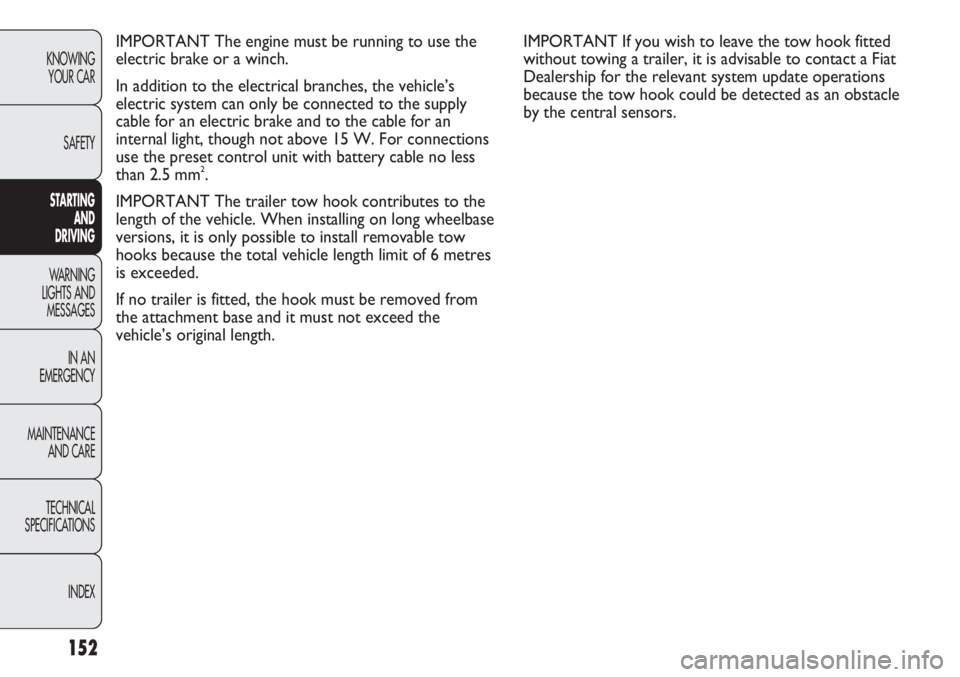
152
KNOWING
YOUR CAR
SAFETY
STARTING
AND
DRIVING
WARNING
LIGHTS AND
MESSAGES
IN AN
EMERGENCY
MAINTENANCE
AND CARE
TECHNICAL
SPECIFICATIONS
INDEX
IMPORTANT The engine must be running to use the
electric brake or a winch.
In addition to the electrical branches, the vehicle’s
electric system can only be connected to the supply
cable for an electric brake and to the cable for an
internal light, though not above 15 W. For connections
use the preset control unit with battery cable no less
than 2.5 mm
2.
IMPORTANT The trailer tow hook contributes to the
length of the vehicle. When installing on long wheelbase
versions, it is only possible to install removable tow
hooks because the total vehicle length limit of 6 metres
is exceeded.
If no trailer is fitted, the hook must be removed from
the attachment base and it must not exceed the
vehicle’s original length.IMPORTANT If you wish to leave the tow hook fitted
without towing a trailer, it is advisable to contact a Fiat
Dealership for the relevant system update operations
because the tow hook could be detected as an obstacle
by the central sensors.